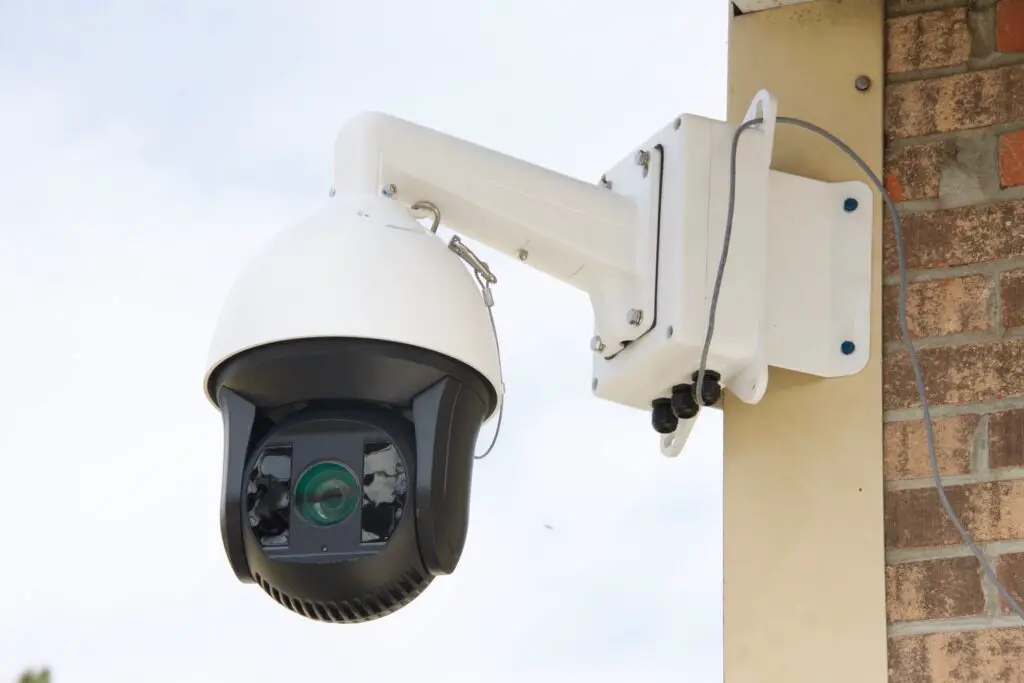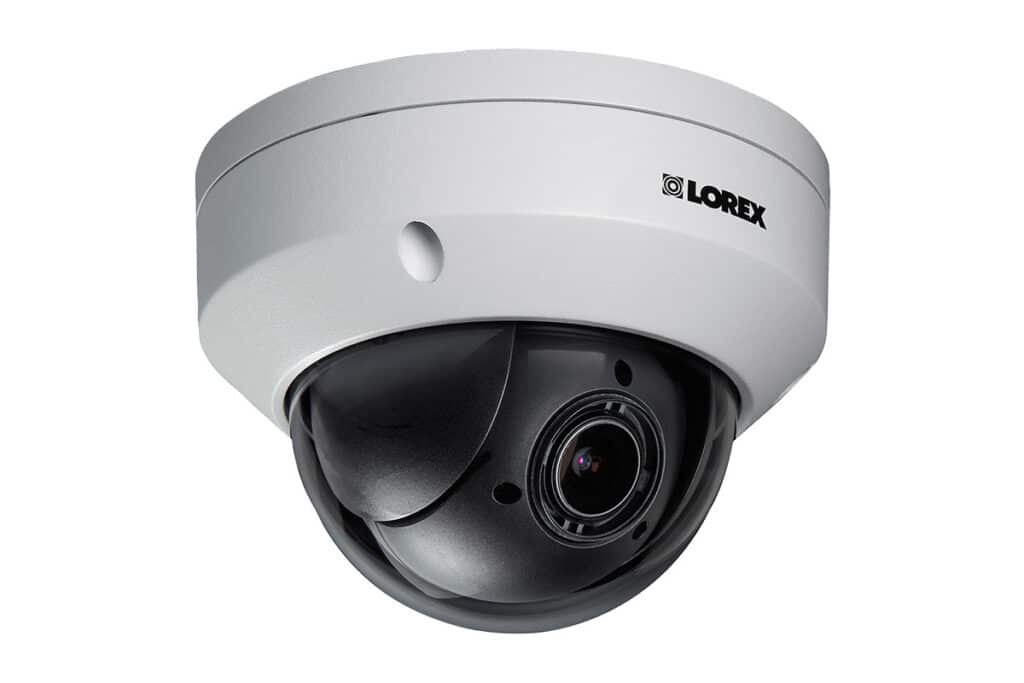Introduction
What Is Ptz Security Camera: PTZ security cameras are designed to cover larger areas and capture more detailed footage compared to fixed cameras. With the ability to pan horizontally (rotate from left to right), tilt vertically (tilt up and down), and zoom in or out, PTZ cameras can effectively track and monitor objects or areas of interest in real-time.
The pan function allows the camera to rotate horizontally, typically covering a 360-degree field of view. This wide-ranging movement enables operators to scan large areas or follow moving subjects seamlessly. Tilt capability allows the camera to adjust its vertical angle, providing a comprehensive view of the monitored area, from floor to ceiling.
One of the most notable features of PTZ cameras is their zooming capability. Optical zoom allows for the adjustment of the camera’s lens, magnifying the image without any loss in quality. This feature is particularly beneficial for capturing fine details or zooming in on distant objects, such as license plates or facial features.
Modern PTZ cameras are equipped with advanced technologies to enhance their functionality. These cameras often incorporate auto-tracking, where they can automatically follow and zoom in on moving objects or individuals. They may also include motion detection sensors, night vision capabilities, and image stabilization to ensure clear and reliable footage regardless of lighting conditions or camera movement.

What is PTZ security camera?
PTZ cameras are pan, tilt and zoom robotic video cameras that allow an operator to control the camera remotely. PTZ cameras can pan horizontally, tilt vertically and zoom in on a subject to enhance the image quality without digital pixelation.
Fixed cameras can only see a small area, but a PTZ camera can see more and catch better video. With the pan feature, the camera can turn horizontally, usually to cover a full 360-degree field of view. This wide-ranging movement lets workers look over big areas or follow moving objects without any problems.
Tilting the camera vertically gives a full view of the monitored area from floor to ceiling. PTZ cameras can zoom in on distant objects or capture tiny details without compromising picture quality.
PTZ cameras can track objects and people in real time, which is a major benefit. These cameras can track subjects as they move across the monitored area using pan, tilt, and zoom. This function is beneficial in retail outlets, airports, and public venues where constant surveillance of a person or item is needed.
0reas. Their adaptability makes them suited for many applications that need active monitoring and reaction.
Do PTZ cameras need power?
You have two options when it comes to providing power to PTZ cameras: 1) use the power supply that comes with the camera or 2) use a multi-camera power supply that can supply multiple cameras from a central location. These multi-camera supply packs are available in both 12v DC and 24v AC versions. 2.
PTZ cameras usually require a constant power source to operate continuously. This power is necessary to run the camera’s internal circuitry, image sensors, processors, and other components. The power supply can be either provided through a wired connection or wireless means, depending on the camera’s design and specifications.
When connected to a power source, PTZ cameras use an Ethernet cable or other power connection. The power line connects to a wall socket or camera-specific power supply box. PTZ cameras need varying quantities of energy, so make sure the power supply matches.
Wireless power options, such as Power over Ethernet (PoE), are also available for PTZ cameras. PoE allows both power and data transmission to occur over a single Ethernet cable, simplifying installation and reducing the need for separate power cables. However, it’s important to ensure that the PTZ camera and the network infrastructure support PoE.
In addition to the power required for the camera itself, PTZ cameras need additional power to operate the pan, tilt, and zoom movements. These motorized movements require electrical power to rotate the camera horizontally (pan), adjust the vertical angle (tilt), and control the zoom function.
What is the range of PTZ camera?
Long range IP PTZ camera with a range of 5,10,15 km range.
The zoom capability of a PTZ camera plays a crucial role in determining its range. PTZ cameras often come with optical zoom lenses that allow for variable magnification without any loss in image quality. The zoom range is usually specified as a ratio (e.g., 20x zoom), indicating how much the camera can magnify the image compared to its widest field of view.
The zoom range enables PTZ cameras to capture clear details even from a considerable distance. For instance, a 20x zoom camera may clearly photograph or film things 20 times further away than its largest field of view. Note that zooming narrows the range of vision, concentrating on certain regions or objects.
The resolution of a PTZ camera is another crucial factor that impacts its range. Resolution refers to the number of pixels in the image, determining the level of detail that can be captured. Higher resolution cameras can capture finer details and provide clearer images even when zoomed in. PTZ cameras are available in various resolutions, such as HD (720p), Full HD (1080p), and even Ultra HD (4K).
The higher the resolution, the more detailed the image will be, enabling the camera to capture clear visuals even when zoomed in on distant objects. A higher resolution camera will generally have a longer range compared to a camera with a lower resolution.
What is PTZ camera speed?
Note: The PTZ speed can be adjusted between 1 – 8, 1 being the slowest and 8 being the fastest speed.
PTZ cameras’ pan and tilt speeds indicate how quickly they can pan and tilt. This speed, usually in degrees per second (°/s), indicates how rapidly the camera can cover an area or track moving objects.
Pan and tilt speeds vary per PTZ camera model. Some cameras have slower speeds for scanning a vast area methodically, while others have higher speeds for reacting rapidly or tracking moving objects. Speed parameters may often be adjusted for a monitoring operation.
Zoom speed is how fast a PTZ camera lens may expand or contract its field of vision. This speed is commonly measured in zoom ratio/second. With faster zoom, the camera can quickly zoom in or out.
Zoom speed is essential for tracking moving objects or capturing details from afar. A fast zoom speed lets the camera capture important information when the monitoring area changes.
Preset speeds and patterns: PTZ cameras can store and retrieve preset locations and patterns. The camera may swiftly move to preset locations or angles, whereas patterns are sequences of preset motions.
Why are PTZ cameras so expensive?
PTZ camera prices depend on many factors, including: Pan, tilt, and zoom motor quality matters. Moving camera motor sounds. Construction materials for the camera.
Motorized Movements: PTZ cameras are equipped with motors that enable pan, tilt, and zoom movements. These motors require precise engineering and construction to ensure smooth and accurate camera movements. The manufacturing and integration of these motorized mechanisms contribute to the higher cost of PTZ cameras compared to fixed cameras.
Optical Zoom Capabilities: One of the distinguishing features of PTZ cameras is their optical zoom capability. Optical zoom allows the camera to adjust the lens focal length, magnifying the image without any loss in quality. The inclusion of high-quality zoom lenses with variable zoom ratios adds to the cost of PTZ cameras. The complexity of these lenses, along with the need for image stabilization, further increases the overall cost.
Advanced Technology: PTZ cameras often incorporate advanced technologies to enhance their functionality and performance. These technologies can include auto-tracking, motion detection, image stabilization, and intelligent analytics. Integrating such features requires additional components, processors, and software algorithms, leading to higher manufacturing costs.
If the zoom speed is faster, the camera can respond more quickly to changes in the area being watched, making sure that important details are caught correctly.
Do PTZ cameras work only with Internet?
If IP cameras, despite the moniker “Internet Protocol,” do not need a live Internet connection, how to power a PTZ Camera then? Having access to a LAN is all that’s needed. For example, you might connect your IP camera to your computer’s Ethernet connection to create a very simple version of this LAN.
Local Connectivity: PTZ cameras typically require a local power source to operate. They need a direct power supply to power their internal components, motorized movements, and optical zoom functions. Power can be provided through wired connections to a power outlet or through wireless options such as Power over Ethernet (PoE), where power and data transmission occur over a single Ethernet cable.
Video Transmission: PTZ cameras can transmit video signals through various means, even without an internet connection. The most common method is through wired connections using coaxial cables or Ethernet cables, which can carry video signals to a local recording device or monitor.
PTZ cameras: can also utilize wireless transmission technologies such as Wi-Fi or radio frequencies to send video signals wirelessly to a compatible receiver or recording device. These wireless connections operate within a local range and do not necessarily rely on internet connectivity.
Local Recording and Control: PTZ cameras frequently include SD card ports for local video recording. The camera may operate without internet access with this capability. After recording, the film may be examined on the camera or uploaded to a computer or storage device for analysis.
What power supply required for PTZ camera?
PTZ IP cameras can use POE connectivity to power them adequately. Cameras often: Require 12v DC or 24v AC. Come with their own power supply.
Can you control PTZ cameras remotely?
A networked PC with PTZ Optics software is a reliable and affordable way to remotely control your PTZ camera. This program gives customers complete control over their PTZ cameras from anywhere on their LAN.
Internet access allows remote PTZ camera operation. The camera communicates with a computer, smartphone, or tablet through a wired or wireless network. Users may operate the PTZ camera from anywhere with an internet connection.
Remote access software or mobile apps for PTZ camera management may be used to remotely operate PTZ cameras. These software or applications include an easy-to-use interface for seeing the camera stream, moving it, and zooming.
Distant access software or apps link distant devices to PTZ cameras for real-time control and monitoring Passwords and encryption should safeguard the PTZ camera and remote access software or app connection.
Remote pan, tilt, and zoom control lets users operate PTZ cameras from afar. To concentrate on certain regions or objects, users may pan, rotate, and zoom the camera.
Remote camera control is useful in surveillance situations that need real-time monitoring and tracking. Without touching the camera, operators may alter its location or zoom to react to occurrences or changes in the surveillance area.

Conclusion
They can follow moving objects, cover large areas, and zoom in on details.Security and law enforcement organizations may precisely and efficiently monitor and react to possible security concerns with this flexibility.
Modern outdoor ptz include auto-tracking, motion detection, night vision, and picture stabilization in addition to pan, tilt, and zoom. These innovations improve the camera’s performance and assure high-quality video in diverse lighting and environmental circumstances.
With their widespread usage in public spaces, commercial properties, industrial sites, and residential areas, PTZ security cameras have become an integral part of modern security systems. Their presence acts as a deterrent to potential intruders and provides valuable evidence in investigations. PTZ security cameras offer a powerful and versatile surveillance solution, surpassing the limitations of fixed cameras. Their pan, tilt, and zoom capabilities, coupled with advanced features, enable effective monitoring, tracking, and response to security incidents.

